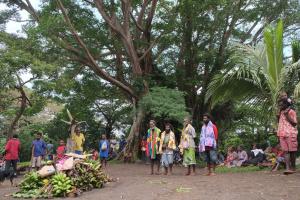 It has been an unusually wet couple of months. They tell us that this is the dry season and that there are sometimes even droughts in this part of Tanna, but this year it has been wet and windy. In fact it has been so wet that at times it has slowed my work in visiting mission fields.
It has been an unusually wet couple of months. They tell us that this is the dry season and that there are sometimes even droughts in this part of Tanna, but this year it has been wet and windy. In fact it has been so wet that at times it has slowed my work in visiting mission fields.
I am not the only one whose work has been slowed. There are three trucks in this part of Tanna other than mine. Last week the drivers went together to see the ‘kastom man’ who ‘works’ the rain to accuse him of using the rain to spoil their businesses. You see, on Tanna, rain is thought to be controlled by people.
Rain is ‘worked’ in the sense that a particular person in an area performs an elaborate ceremony. The rain is produced by a synergy between the mental state of the person performing the ceremony and the elements involved, which in this case include a particular stone and certain leaves which are submerged in fresh water.
Of course there is more to rain than simply causing it to fall out of the sky. The wind has to first blow the clouds overhead. That is the work of another ‘kastom man’ using a different kind of leaf, and so the two have to work together to produce the rain. There is a different person who ‘works’ the sunshine and of course that will require a different wind direction and different leaves.
Cyclones are also controlled. Earlier this year, I was at a ceremony commemorating a

All this is part of what is called ‘kastom,’ which is the magic-religious world-view which pervades Tanna. Kastom is generally about producing what is good or desirable for the person or people involved in it. Those who have the (usually) inherited responsibility of ‘working’ various elements go under the broad banner of ‘kastom men.’ Interestingly, these men who ‘work’ rain are organised into a kind of network, like a guild, whereby they can standardise practices and organize their work.
Two of the vehicles in our part of Tanna are new and although the road has, on all but one occasion, been open to where we are, it gets very muddy north of us and has been impassable on many occasions. The accusation, which was denied, was that the rain was being ‘worked’ so that the drivers couldn’t make their money as transport drivers.
Last year when I was on Tanna in August there was also unseasonal rain. I was told that the reason on that occasion was that one group had planned a circumcision ceremony but another group did not think that they were going about it the proper way and so ‘worked’ the rain so as to prevent the ceremony going ahead. I met some tourists who had been invited to the circumcision and they told me that indeed the ceremony had been abandoned due to torrential rain.
Interestingly, I had just landed from Aniwa, a small island about 30km to the north-east, where I had been at the assembly of the Presbyterian Church. Aniwa was experiencing the exact same weather pattern that Tanna was, but there we were giving thanks to God for his provision. Aniwa is a very small island with low rainfall and frequent water shortages, but had a couple of hundred guests for the Paton memorial Assembly. The rain meant that we could all have showers!
